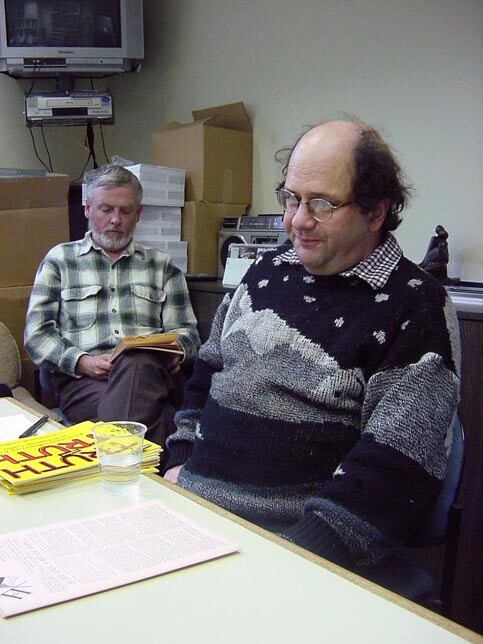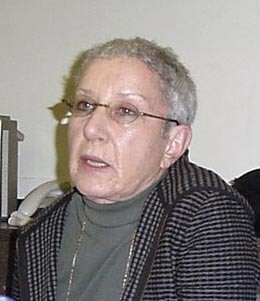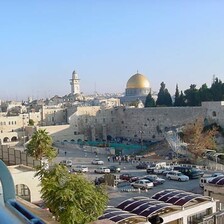Gush Shalom
March 10, 2005 — After the water tower tour in Kafr Saba, we head south on the highway to Tel Aviv. We arrive at the offices of Israeli Physicians for Human Rights.
We meet Adam Keller, editor of The Other Israel, and prominent member of Gush Shalom, and Peace Now.

Adam Keller of Gush Shalom and The Other Israel. (Photo: Bill Dienst)
Mr. Keller explains the premises of his organizations. Israel-Palestine is the home of 2 peoples; neither has the power to throw out the other. One side is militarily strong, the other side militarily weak, and hence, resorts to suicide bombing as their primary means to address violence with violence. But there is a better way.
There is the Two State Solution: Two States, Israel and Palestine, each with its Capital in Jerusalem. The borders are roughly those of the Green Line, prior to 1967. Although there could be some minor modifications, or land swaps, based on mutual consensus.
Ariel Sharon, the current Prime Minister of Israel, says that he is for a two state solution, but there is a vast disconnect between what Ariel Sharon says and what he does.
Mr. Keller goes back to his youth. Normally, all Israelis are conscripted for 3 years into the military. Adam Keller’s time of military service occurred during Israel’s invasion of Lebanon, and subsequent occupation of Southern Lebanon. This all started in 1982, when Menachem Begin was Prime Minister, and Ariel Sharon was Defense Minister. As a recruit, Adam Keller refused military service in Lebanon, and he was sent to a base in Northern Israel.
One night, he became a graffiti artist and spray-painted peace slogans all over some Israeli tanks. He faced charges of “Spreading Propaganda Harmful to Military Discipline”, was convicted by a military court, and ended up serving three months of a three year term.
One of the few benefits of prison was that he was able to become acquainted with the different ethnic backgrounds of Israeli society. For example, in his experience, Argentinean Jews tended to be on the Left, Russian Jews have a tendency to be on the Right, and the Druze tend to represent “the worst of both worlds.” He came to enjoy “prison democracy”. After all, there was nothing else to do. Political debate became the best entertainment around.
“The Brigadier General had a thick folder on me,” he says. After being released from prison, he was again forced into one more year of compulsory military service in 1989. He began first by refusing to go to Lebanon, or to the Occupied Territories, and then this became a total refusal to participate in the military whatsoever. He was sentenced to one month more in prison. He then refused to wear his military uniform, and then refused to call the military guards “Sir”. They forcefully undressed him.
Adam Keller explains, “Once you have decided not to be intimidated, you are not.” He went on a hunger strike. He was finally discharged from the Army for psychiatric reasons. “If you become a trouble maker and are in prison multiple times, then they look for a reason to finally throw you out for psychiatric reasons.” He was advised by friends, “Look, if they send you to the psychiatrist, just try and play along and you will get a discharge. If you apply for Consensus Objector status, you will be in and out of prison for the rest of your life.”
The day came when Adam Keller was formally evaluated by the Military Psychiatrist:
“Are you controlled by creatures from another planet?
“No!”
“Do you hear voices?”
“No.”
“Where do you get your inspiration?”
“I don’t know.”
“Are you hearing The Voice of History?”
“Sometimes when I close my eyes, I see the Dead Sea Scrolls!”
Bingo! Adam Keller was finally discharged for good from the Israeli Army due to a Psychiatric condition.
The genes seem to run in the family. Adam Keller’s son has subsequently been imprisoned for one year for being a Refusenik.
Adam Keller works closely with Gush Shalom founder Uri Avnery, whom in his eighties, is still a prolific writer and quite vigorous. Mr. Keller believes that it would be better for the country if there were a separation of Religion and State in Israel. After all, the majority of Jews in Israel are secular Jews. There are also other non Jewish ethnic minorities, such as the Israeli Arabs and the Druze.
“There are all kinds of archaic religious laws. For example, there is no civil marriage in Israel. There is this naive belief that, ‘if people are exposed to secular ideas, they will loose their identity as Jews.’”
A member of our delegation asks a simple question, “How broad is the peace movement in Israel?” Mr. Keller gives us a complicated answer. There are basically five major segments of Israeli society. There are the mainly east European, or Ashkenazi Jews, who are the elites, like the WASP’s in American Society. Then there are the Sephardic or ‘Arab Jews’. Then there are the Russian Jews, the Orthodox Jews, the Arab Israelis (native Palestinian-Arabs and the Druze), and all the rest: Ethiopian Jews, Russian-Christians, Bahai’s, etc.). Israel is a much more diverse society than most outsiders appreciate.
“Each of these groups constitute roughly one million people, and different ideologies are predominant within each of these groups. The religious Jews tend to be the most ideologically right-wing, with a few exceptions. At the core, these are only about 100 to 200 thousand people, out of a total population of about six million.” But they have a disproportionate amount of power in Israel, since Israel is officially a Jewish state.
It seems to me that Israel is ironically similar to the Islamic Republic of Iran, in this way. In Iran, the orthodox Shiite Muslims wield a disproportionate sway over the population there. I see what Mr. Keller is saying. It seems that both societies could be much more democratic if they could separate their respective dominant religion from their states.
Mr. Keller is optimistic about the future of the Israeli peace movement. “Sharon has now discredited the War Option, and he has shown that it is not effective.” Mr. Keller says that since 2003, there is a growing shift to the Left in Israeli public opinion. There is a growing acceptance of a two state solution among 30-40% of the Israelis. There is growing pressure from the majority of Israelis to disengage from Gaza.
Sharon is withdrawing from Gaza, while trying to reinforce the settlements in the West Bank. The extreme right is now calling Sharon a traitor, and he is now delaying the withdrawal from Gaza for as long as he can. But now there is too much invested both locally and internationally, for him to pull out at the last moment. It seems that withdrawal from Gaza will occur in July/August of 2005. Adam Keller says, “The withdrawal from Gaza will be a beginning first step, but it will not be enough.”
Physicians for Human Rights

Dr. Ruhama Marton, an Israeli psychiatrist and founder of Physicians for Human Rights. (Photo: Bill Dienst)
Dr. Marton began working with Palestinian physician colleagues in the West Bank and Gaza during the late 1970’s and early 1980’s. At that time, governmental hospitals in the West Bank and Gaza, which had previously been administered by Jordanian and Egyptian authorities prior to 1967, came under the control of the Israeli Civil Administration, the military arm of the Israeli government which governed all social services in the West Bank and Gaza after the conquest of the Six Day War.
Dr. Marton toured the Shifa Hospital in Gaza City, a hospital for Palestinians that was administered by the Israeli Civil Authorities. She was appalled by the extremely poor conditions of the government hospitals!
Private hospitals like Al Maqassed Hospital in Jerusalem, or Ahli Arab Hospital in Gaza in these same areas were financed more compassionately by Non-Governmental Organizations (NGO’s) in the Arab World, Europe and the US. These facilities were much better. Palestinians who had the means would avoid the government hospitals because they were controlled by the Israeli Civil Administration, and bled dry by insufficient financing into disrepair.
In East Jerusalem, the Jordanians had just finished building the Sheikh Jarra Hospital in 1967; the Israelis converted it into a police station. Just northwest of Nablus, on the road to Qalqilya, a former government hospital became the Jneid Prison.
In the Old City of Jerusalem, there was the Hospice Hospital, across from the Third Station of the Cross on the Via Dolorosa. It had served the Old City’s population for over 30 years. Over the years between 1967 and 1985, its finances were bled dry by the Israeli administration. Finally in July 1985, it was closed by force by the Israeli authorities. I was living in the Old City that summer. A few days before the scheduled closing, Israeli soldiers showed up unannounced, and carried the remaining patients out into the street and put a padlock on the door. A few were taken to the Hadassah Hospital. In this way, the Israeli government avoided most of the adverse publicity: the planned protests and media attention. The building has since been given back to the Austrian Church, who were always the proprietors.
In 1985, I was shown many of these same government hospitals informally by local Palestinian physicians. I know firsthand what Dr. Marton is talking about. Creating a dependency on Israeli health care services is another way to exert control over a population. You can also show the world images of enlightened Israeli healers showing compassion toward these backward Arabs, and fool the world again.
Dr. Marton saw this too, and found it to be unconscionable. She is a woman of sincere compassion and great courage. She began collaborating with Palestinian physicians in the West Bank and Gaza, including Dr. Eyad El Sarraj, who is the head of Gaza Community Mental Health Programme (GCMHP). In the past 3 years, her organization’s efforts in Gaza have been stymied. She has not been permitted to travel to Gaza for over 3 years now. Most Israeli’s are not allowed into Gaza, unless they take the bypass roads directly into the settlements. Currently, she balances her time between doctoring and fighting for human rights.
A member of our delegation asked her about the ongoing effects of occupation on Israeli society. “We’re the Zionist-Jewish Israelis. We were overwhelmed with surprise when the bomb went off in Netanya during Passover, 2002 and killed so many. We asked ourselves, ‘How Come?’ as if nothing had happened before. We don’t want to see a connection between what we have been doing in the Occupied Territories, and what was done to us. There is never a connection.”
“And if there is no reason, we become overwhelmed with anxiety and fear.” When the re-occupation of the West Bank and Gaza began in March, 2002, the peace movement was stifled. People have had bumper-stickers on their cars which read, LET THE IDF WIN! (Israeli Defense Forces) Now there is an inner conflict in Israel that the IDF can and must win. There has since been extremely heavy military action, but still, the IDF has not ‘won’.
Now there are over 8,000 Palestinians who have been swept up forgotten by the world in Israeli jails. “We are now becoming more aggressive in the Occupied Territories and at home… on the outside and on the inside. It has been spreading like a virus. Now more and more women are being killed by their spouses and boyfriends (femicide); the numbers have been doubling every year. We are now number one in the Western World in youth violence. Tension and Rage are more inherent as we continue to become an increasingly violent society. There are more random murders which follow a fight over minor situations, like fighting over parking spaces, etc. All kinds of extremely aggressive people have been moving here from the USA. Our press and media are not receptive to this message, and will not report about it.”
As I listen to this, I cannot help but seeing parallels about what is going on in Israel, and what is happening in the USA right now. After 9/11, we Americans fail to see the connection between what was done to us and the injustices of our country’s foreign policies in the Middle East and elsewhere. People are putting Yellow Ribbons all over their cars which admonish us to “Support the Troops”; this becomes tacit support for Bush’s ill-fated invasion and occupation of Iraq. But there are differences as well; we ignore it when our troops commit atrocities half way around the world. In Israel, the abuses are also being ignored, but they are happening right in their own backyard.
We leave Tel Aviv, and head to Jaffa. We have dinner at an Israeli-Arab restaurant called Abu-Lafiya. We look back across the water at downtown Tel Aviv, and it looks beautiful. It reminds me of the view from Alki Beach in West Seattle into downtown.
As we ride the bus back to Jerusalem, I pray that both of our countries, Israel and the USA, can find a more humane way out of our current quagmires.
Next, the International Solidarity Movement
Dr. Bill Dienst is a rural family and emergency room physician from Omak, Washington, USA. In March 2005, he traveled to Palestine and Israel as part of a delegation sponsored by Washington State Physicians for Social Responsibility (WaPSR). The delegation met with prominent Palestinians as well as members of the Israeli peace movement. They also traveled inside the Kiryat Arba’a settlement to hear a prominent member of the settler movement. In this series of articles, Dr. Dienst describes these meetings. Dr. Dienst has been to Israel-Palestine twice before. In November 2003, he spent 10 days in Gaza sponsored by Gaza Community Health Programme, and in 1985, he spent 4 1/2 months in Egypt the West Bank and Gaza sponsored by the Palestine Red Crescent Society.





